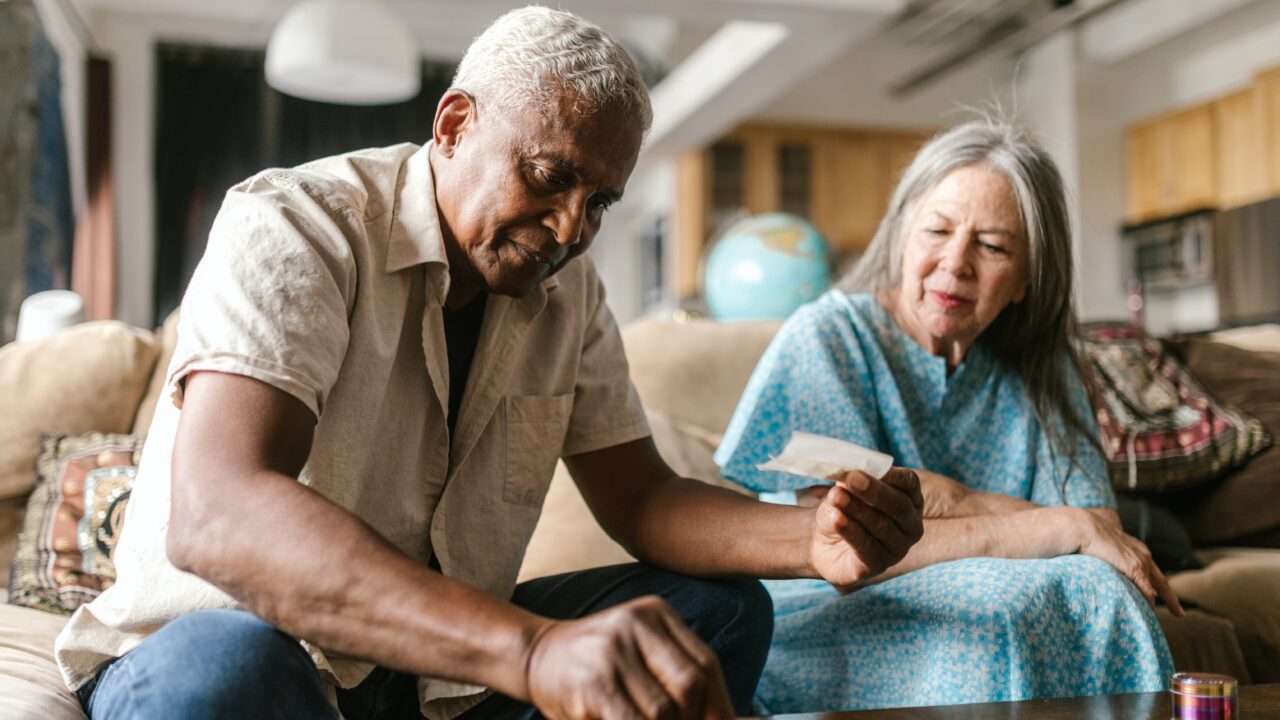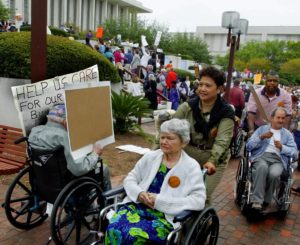Why Is Getting Old So Hard and Expensive in America?
In "The Measure of Our Age," elder justice expert M.T. Connolly offers both a warning and challenge about our eldercare systems. An Elderly man and woman by RDNE Stock project
via Pexels / CC BY-SA 3.0
An Elderly man and woman by RDNE Stock project
via Pexels / CC BY-SA 3.0
The following story first appeared in the Institute for New Economic Thinking.
We’re not ready for old age. Not as individuals, not as a society. That’s the sobering news from lawyer M.T. Connolly, former coordinator of the Elder Justice and Nursing Home Initiative at the U.S. Department of Justice. In her new book, The Measure of Our Age: Navigating Care, Safety, Money, and Meaning Later in Life, she outlines how our institutions, laws, and cultural practices have failed to keep up with our amazing advances in longevity over the last century. As a result, many, if not most of us, are spending our final years with far less security, health, purpose, and joy than we could be having. (Americans have been falling behind peer countries on mortality rates in recent years).
We aren’t prepared to care for people living longer, either. As many a midlife person can tell you, I’ve found my own journey through the land of caring for an elderly parent to be difficult in ways I never anticipated—often unnecessarily so. Gaps and ambiguities in the law made it hard to figure out who could decide and do what, despite my mother’s diligent planning. Well-known financial institutions my family had trusted for decades turned out to be predatory—with whole divisions set up to take advantage of an aging population. Help was hard to come by, as was knowledge of how to navigate confusing systems of insurance, home care, and the constantly-shifting needs of a person with diminishing capacity. All of it was crushingly expensive—and my mother was one of the lucky ones of her generation, reaching old age with a pension and educated children to help oversee her medical needs and combat the scammers that seemed to lurk around every corner, some wearing handyman overalls, others in suits and ties.
Connolly has written a book not just to warn us, but to prepare us and to offer insight into the changes and adaptations we must make in order not just to live longer, but to live longer better. She spoke to the Institute for New Economic Thinking about what prompted her to take on the challenge of aging and what she envisions for a final stage of life that is healthier and happier.
Lynn Parramore: How did you come to specialize in the topic of aging?
M.T. Connolly: I thought I was going to follow my mother into psychiatry and took a deep dive into the mental health system by living in a state hospital as a resident volunteer, where I got interested in what society does to help vulnerable people. What are the systems? I ended up going to law school and then went to the Department of Justice (DOJ), a great place to learn how to be a lawyer. For years I was a civil fraud lawyer, but eventually, I went back to issues that had drawn me to law school in the first place when I had the opportunity to head up a project at the DOJ called the “Nursing Home Initiative” (later renamed the “Elder Justice Initiative”). The more I saw the more I realized, gosh, these problems are long-standing and huge, and we’re not close to ready for the needs of an aging society.
LP: In what ways are we not ready?
MTC: We’ve managed to extend life in this phenomenal way. We gained, on average, 30 years of life in the 20th century. But that longevity has unintended consequences. People 85 and older are the fastest-growing segment of the population. But our lifespans are not matched by our health spans. As people live deeper into old age, millions more of us are going to need care, and we don’t have the infrastructure to provide it.
We have three ways to care for people who need care: family or “informal” caregivers, paid caregivers in the home, and residential care.
In the informal care economy we have 40 million people—more than the entire population of California —providing an average of 24 hours of care per week. That’s a lot of people, a lot of really hard work. It can be very intensive clinical care, and can raise complicated issues, like how to balance autonomy v. safety. Many are thrust into the caregiver role unexpectedly and have no idea how complicated and arduous it can be. We don’t have good infrastructure to help them, even though there’s this enormous shadow economy. The value of informal care is estimated to be around $500 billion a year—and the lost income of those caregivers is also about $500 billion. There are huge health implications of caregiving that we’re not measuring the cost of: anxiety, depression, and heart disease. Lots of caregivers also reduce hours or leave their jobs altogether. We’re not doing honest math in terms of the economics of relying so heavily on informal caregivers in this massive new longevity economy.
In the informal care economy we have 40 million people—more than the entire population of California —providing an average of 24 hours of care per week.
Then there are paid caregivers that come into the home. Most older people don’t have sufficient income to pay for them, so again we have this mismatch. This system is enormously complicated, too, in terms of how it’s funded, how it’s reimbursed, who is available, and what different kinds of work those aides, therapists, and home health workers do. A lot of caregivers also are paid and treated really poorly. Ai-Jen Poo, who runs the Domestic Worker’s Alliance and Caring Across Generations, has raised the issues of family and paid caregivers and their importance to the economy’s functioning. There’s also a dire shortage of direct care workers in all settings, in large part because we’ve paid and treated them so poorly.
Residential care is divided into several different categories. You’ve got nursing homes, assisted living, group homes, and then something called “Continuing Care Retirement Communities” (CCRCs), which is the soup-to-nuts option—meaning you can choose an independent living apartment and then add or move into options like skilled nursing or memory care if you need it. The pandemic reminded us—though we’ve known it a long time—that even though there are some wonderful options, a lot of them are really bad. The system is broken.
We can’t look at just one slice of the care environment in isolation because they’re all related. Interestingly, we know way more about nursing homes than we do about the other options, like assisted living and group homes, because we collect more data on nursing homes. But we don’t really know that assisted living or group homes are better or worse than nursing homes because we don’t collect data that allows us to compare them. That’s a huge issue. Assisted living and group homes are subject to state and local regulation, but states vary wildly in terms of oversight and data collection. There are also big issues of fiscal stewardship. We know that nursing homes and CCRCs together get over $100 billion a year in taxpayer money—but there’s very little understanding or transparency about how they spend that money or how much of it actually goes to resident care. We should know that information—as taxpayers, consumers, and policymakers.
LP: You discuss some of the ways the push for profits can compromise care in long-term facilities. What are some of the most concerning areas?
MTC: One area I talk about is the issue of parent companies owning subsidiaries, and other “related parties.” This happens when a bunch of entities are part of the same corporate family, and the transactions among them are not necessarily arms-length or happening at fair market value. Prices are often inflated. The Consumer Voice for Quality Long-Term Care, a leading advocacy organization, released a report in March on how nursing homes funnel billions of dollars through related party companies with little scrutiny from the federal government. It’s a pervasive problem and has been for a long time. This is another issue in need of greater oversight and transparency.
Then there’s the role of private equity. Increasingly, these entities are buying up care health and long-term care providers. The private equity model is to acquire assets, to squeeze them or to make them “more efficient,” and then to flip them. Research has shown that nursing homes owned by private equity, on average, are worse than for-profits under different kinds of ownership. And the data also indicate that on average, for-profit entities provide worse quality care than non-profits.
LP: Why is that?
MTC: My hypothesis is that not enough money goes to care because it’s being moved out of the operation. There’s a relatively simple fix and it’s sort of mystifying why it hasn’t happened already, which is to require transparency and accountability about how money is being spent and how much of the $100 billion in taxpayer dollars is actually going to resident care or other stuff that directly benefits residents. We don’t know the answer to that. We often don’t even know who owns a facility.
Being a former fraud lawyer, I’ve learned that when entities have to certify how they’re spending federal dollars and state dollars, it gets their attention because then they’re on the hook for it under the False Claims Act. If they’re making a claim for reimbursement under Medicaid or Medicare or some other public program, and certify something that’s not true, that can create a cause of action. Certified reports on how they spend the money and who owns the facility, what the ownership structure is, increase accountability. The onus should be on the owner to tell the public funders when there’s a change of ownership. There should be a public record. And consumers should have access to that information, too.
In the caregiving world, there’s been a lot of talk about how AI and tech more broadly are going to become stand-ins for caregivers. Like robots.
There should also be guardrails and clear guidance about what’s appropriate in terms of fair market value. We need sunshine. A lot of money already goes into eldercare—hundreds of billions of dollars—and much is not well spent. We need to think carefully about how we achieve the greatest good in deciding what we reimburse. In general, we’re much more inclined to reimburse procedures, drugs, and devices than preventive care. Health and long-term care businesses have great influence over the political process – much more than the vulnerable people who are being cared for in these facilities. Too often the rules don’t align with the wellbeing and interests of the people those programs exist to serve. That’s a problem.
We also need to understand more about the financing and quality of care in assisted living and group homes and some parts of CCRCs because they’ve gotten a pass in terms of scrutiny and public awareness. The public knows that nursing homes are a troubled sector that needs reform, but we don’t know that much about assisted living. For example, if you pay a lot to get into an assisted living facility, under what circumstances can they kick you out? And when can they force you to buy expensive additional services that you don’t think you need?
The rules are so complicated and systems so siloed that older people and those who care for and about them really need good advocates. Good elder law attorneys or care managers should know the laws and how the financing works. And there are long-term care ombudsmen available everywhere, and their services are free. But you can’t just call a national hotline. A lot of it is very local in terms of which facilities are good and which ones have problems.
LP: Of course, as you point out, finding a good advocate can be expensive. Yet one of the takeaways from your book is that even having a lot of money does not protect you from harm in old age. What do we need to be thinking about in terms of protecting senior finances, both as a society and as individuals and families?
MTC: Legal aid providers across the country provide services at no charge to people with lower incomes who can’t afford private lawyers, and there are a few free volunteer-based elder financial advisor programs. But you’re right, hiring private counsel or financial advisors is pricey.
We need to educate people and push the financial industry to implement more effective protections. Financial institutions can and in some places must report suspicious activity. They should offer and help customers include a trusted contact on accounts and not just make an assumption about who that person is. It’s like the emergency contact in the doctor’s office.
Also, if the institution sees something fishy in a transaction, they can delay disbursement to look into it. A lot of times, once the money’s gone, it’s gone. The National Bureau of Economic Research did a study that showed a pretty significant impact in terms of reduction of harm from a FINRA rule allowing (although not requiring) financial professionals to halt disbursement of funds if they suspect there’s some kind of financial fraud involved. That’s hopeful. Brokers are generally using protections because FINRA requires them to. Banks, less so.
AI is going to make it way easier to target vulnerable people and create really convincing messages to defraud people.
We’ve created automatic systems that help people put away retirement savings or pay bills automatically. Now we need automatic systems that can run in the background to help us protect our money—not just up to but through retirement. There are an awful lot of predators trying to get older people’s money. The system could be triggered, say, when you sign up for Social Security, giving you the option to enroll in a program that helps you protect your assets. We should be using measures we know work more often and pilot-testing others. We also need fraud alerts that pop up — not just for the older person but for trusted others, too. And we need effective, user-friendly support. Bits and pieces exist, but so far it’s mostly for people of means. People without means need financial protection even more because the losses have a much bigger impact.
Regulators should be more proactive and assertive in pushing the financial industry to install better protections. In almost everything that I write about, our approach is reactive rather than proactive. We need to move upstream and ask how to help people prevent trouble as opposed to just calling for more prosecution, more law enforcement, more punishment. Because at that point, the dollars are gone, the suffering has happened, and often a life has been lost.
In families, it’s kind of the same thing. We mostly react to crises instead of moving upstream to have important conversations before a crisis strikes. As a society, we should give families more tools to take stock of assets or to have hard conversations, like about what to do if a parent starts to make risky financial decisions. Families also should talk about where the older person wants to live, what kind of care they prefer and where, how they want to spend their money, who they want helping with finances and with care, and what matters most to them.
LP: You talk about the need for the financial industry to enhance protection. What about when the trusted financial institution is the one doing the predation? We read reports of companies like Merrill Lynch, where brokers have been caught stealing from clients, or insurance companies like John Hancock making it difficult or impossible for people who have faithfully paid premiums to receive coverage, even wrongfully terminating policies. What then?
MTC: When that happens, I’m all for regulators cracking down, and—if necessary—prosecution and penalties that dissuade that kind of activity as opposed to slaps on the wrist. One prosecutor I write about brought a case against a broker at Bankers Life in Seattle who stole a million dollars from 5 different clients. The financial and emotional impact on victims was heartbreaking. Bankers Life ultimately repaid the money, but that happens really rarely. Also, the cost of hiring a lawyer to address these kinds of problems isn’t recouped. Those consequential costs should not be overlooked. It’s profoundly unfair. There’s a serious power imbalance. There have to be the kinds of penalties and causes of action that really do deter that kind of fraud and make it more costly to do it than to not do it. We need to have the Consumer Protection bar more engaged in these issues, and also, to the extent it’s appropriate, look at options for impact litigation.
LP: You talk about AI as part of the solution in the future for creating systems that help with the challenges seniors face. How does this work? And what about the worry that AI will also be used to scam?
MTC: I haven’t seen AI play a significant role yet, but I do think it will have an increasing role over time. One way it’s already involved is with pop-up alerts for unusual activity in accounts. A place where there’s potential is for AI to serve as a kind of clearinghouse to gather a first round of information for consumers looking for help. As all of us are becoming aware, we need to make sure AI is providing the right answers, but when you’re in a particular community and you’re trying to find local providers for your parent or yourself, AI could be helpful in generating an initial list, say, of local home care agencies and nursing homes in a certain radius as well as data on public complaints, staffing, costs, etc. It can be a first cut for people to get the lay of the land. Not a final source of information, but a starting place.
In the caregiving world, there’s been a lot of talk about how AI and tech more broadly are going to become stand-ins for caregivers. Like robots. But that’s not happening yet in any meaningful way, and it raises lots of big questions.
LP: In the book, you talk about PARO, a therapeutic robot in the form of a baby seal, which is meant to reduce patient stress and provide interaction. I’ve got to admit – it looks pretty amazing.
MTC: It’s totally amazing—it’s really tactile and cute. Again, we haven’t seen it play a role yet, really, except for a few outliers. But there are applications that I believe can be helpful—there’s potential for comfort creatures and pill-dispensing robots, for example. And tech can even be useful for socializing— some people actually like interacting with technology. I know a lot of older people who have taken great solace from saying to Siri, “Call my daughter” or “Can you read me JFK’s biography?” Video screens are great for family members to connect. There’s also potential for public awareness, using AI to educate people on issues like autonomy v. safety. Technology can make such education more accessible.
On the other side, AI is going to make it way easier to target vulnerable people and create really convincing messages to defraud people. Also, a lot of care and human connection is deeply personal, so we really have to think about the appropriate role for tech. AI provides vast access to more people and the capacity to analyze data. It can also be dehumanizing. At what point do convenience and expanding resources become a more dehumanizing force? We’re going to need ethicists and philosophers to help us think it through.
LP: You note that old age forces us to deal with quite a few different systems—health, housing, finances, law—often when we are dealing with physical and cognitive challenges. Our society tends to place a lot of the burden on the individual, to see old age as a personal responsibility. Is this thinking flawed?
MTC: On the one hand, we have programs like Social Security and Medicare to support people in old age. In that health insurance and economic support sense, we actually did more for older people than we did for kids for a long time. I think it’s important to acknowledge that. But we have more social connection infrastructure, like schools and jobs, to bring people and families together earlier in life. Parents support to one another in raising kids. But aging and caregiving are often more solo experiences. We basically have these two prevailing aging paradigms: either you live segregated with other older people, or you live isolated in your own home, maybe with a family member. Those paradigms are not ideal for well-being in aging. A lot of people feel very alone.
LP: You also point out that family structure is changing. There are going to be many more aging people who are single, without children, or having had children later in life, so fewer siblings, and fewer older relatives like grandparents around to help. LGBTQ people often do not have biological families to rely on.
MTC: Exactly. People who are aging alone are sometimes called ”kinless” or “solo agers.” How to support them through old age is another growing challenge. This is another way in which our norms and systems haven’t really caught up with our longevity. We’ve focused many resources on growing old but way fewer on figuring out how to assure well-being in old age, both for older people and for the people who care about and for them. We also haven’t caught up in terms of our institutions and systems, or in terms of culture and norms. Right now, I would argue that our norms around aging are often counterproductive. Ageism is pervasive. We don’t have social support to help people navigate caregiving, housing, finances, or even meaning-making. We want those extra years, but we’re not thinking about how to navigate them effectively. We haven’t caught up with ourselves. That’s why I wrote the book.
As a society, we should give families more tools to take stock of assets or to have hard conversations, like about what to do if a parent starts to make risky financial decisions.
I’d worked at the DOJ on policies, programs, and research, and then on the Elder Justice Act. But, I found the results really pretty disappointing in terms of what I was hoping to accomplish. With the Elder Justice Act, I realized that there’s no real political constituency, and no powerful networks, either grassroots or grass-tops, to push for change like there are, for example, in the women’s movement.
It’s a question of building capacity as individuals, in families, and through political networks, to push policymakers and to change norms so that we can better realize the potential of this whole new chapter of life. We haven’t had this opportunity before in human history. My hope is that we begin to embrace aging more as a time of expanded consciousness and creativity, a time when we can explore new kinds of purpose and connection with others. I want us to approach the time with less fear and more hope.
LP: You’ve been involved in a number of efforts to change things. Can you talk about one of the most promising projects? One that you think could be replicated?
MTC: My research for the book helped me understand the problems in a more fundamental sense and what elements we should build into a pilot test. There’s almost no prevention or intervention data. We drive billions of dollars into all these programs but have no idea what their impact is, or how the efficacy of one response compares to that of another. That’s hubris, in my view. I think we have an ethical obligation to measure the impact of our good intentions.
Because I’d worked with and written about the former director of Maine’s Department of Health and Human Services, I asked him if he would let some colleagues and me build a new program to augment what Adult Protective Services (APS) can provide. And he said yes. We wanted to provide the kind of help people want and need, using an advocacy model where the older person was in the driver’s seat. And if they want help for somebody else like a family member or a caregiver, the advocate would be able to get help for that other person too, whereas traditional responders don’t allow for that. We wanted to know: if we built a different sort of model, would it improve outcomes?
We’ve focused many resources on growing old but way fewer on figuring out how to assure well-being in old age, both for older people and for the people who care about and for them.
That’s how we came to build the RISE program in Maine. We test-drove it in two randomly selected counties, which turned out to be the most urban and the most rural. The data have been really promising. For example, working with a RISE advocate reduced APS reinvestigations by 50%. Maine expanded the program statewide with some Covid money, and recently, the governor, at the urging of the new Commissioner for Health and Human Services (a well-respected health policy expert named Jeanne Lambrew) proposed to include RISE as part of the permanent healthy aging programming in Maine. It’s good for the clients and their families. It’s also good for APS workers who want to do well but have structural limits on what they can and can’t do. And it’s good economically because it’s reducing the number of reinvestigations. Now we are in the early stages of piloting the program to provide more options in criminal financial exploitation cases where we also need better alternatives to reduce harm and conflict. Too often instead of investing in trying to prevent problems, we put more resources into punishing people after it’s too late. We need more enlightened choices that are better for everyone involved.
Although I support using prosecution when big institutions abuse or neglect residents, or pilfer funds from vulnerable people, relying on criminal law to address conflict in families is often not the right answer. Often, older people don’t seek help because they’re worried about a family member with addiction or mental illness being prosecuted. So we’re trying to figure out a way to expand the options in those kinds of cases to keep older people safe, to acknowledge their wishes, and to find more meaningful forms of accountability. Our RISE team is working with Page Ulrey, an elder abuse prosecutor in Seattle, and someone whose work I write about, to create a new program with Page’s office, drug court, and RISE. The idea is that if defendants like that grandson meet the terms of the program—like going through drug treatment and more—that criminal charges will be dropped. It’s super exciting. We want to build the prototype with the right amount of caution and thoughtfulness: it’s high risk and high potential. We use several methods in RISE, including not traditional “restorative justice” practices but a related “restorative approach.”
LP: What’s your vision for aging in the future?
MTC: Everyone is aging. Most people care about or for an older person. So it really behooves us to pay attention to these issues and get out ahead of them. We need to push communities, policymakers, and the culture to do a better job in helping us all to find better ways to age so that the options aren’t just isolation or segregation, but instead that we have access to places like “age-friendly communities” that give people of all ages ways to be both separate and together. We also need to push ourselves to resist the fear and shame that pervade aging and approach it with a richer sense of imagination and potential.
It is an extraordinary accomplishment that we’ve lengthened lives. It’s mind-blowing because time is the most precious human commodity of all—being alive. How can we help people to enjoy it and to make meaning of it? It’s not always going to be a walk in the park, but we can do way more so it’s a time filled with connection, awe, and purpose. Even people who have cognitive impairment have the capacity and desire for fulfillment in life.
We don’t want to write off old age. We need to push policymakers to fix the broken systems so that they help instead of hurting our ability to age well. And we need to push ourselves to take more positive control over how we approach the late chapters of our unprecedently long lives.
Your support matters…Independent journalism is under threat and overshadowed by heavily funded mainstream media.
You can help level the playing field. Become a member.
Your tax-deductible contribution keeps us digging beneath the headlines to give you thought-provoking, investigative reporting and analysis that unearths what's really happening- without compromise.
Give today to support our courageous, independent journalists.






You need to be a supporter to comment.
There are currently no responses to this article.
Be the first to respond.